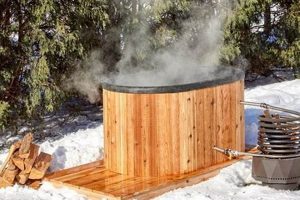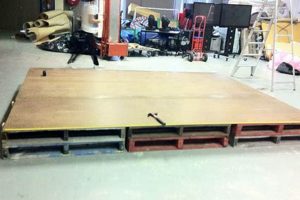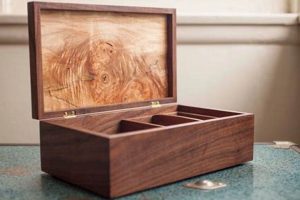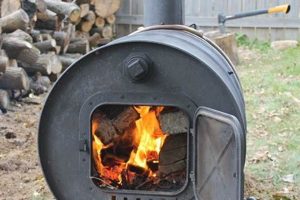A self-constructed outdoor recreational apparatus, generally suspended and designed for swinging motion, often built utilizing timber. These projects provide a tangible form of personal expression and cost-effective means for creating backyard leisure. For example, a simple plank suspended by ropes from a sturdy tree branch embodies the essential characteristics of this pursuit.
The appeal lies in the combination of resourcefulness and customization. Building one fosters a sense of accomplishment and allows for personalization regarding size, style, and materials. Historically, rudimentary versions served as simple forms of entertainment, evolving over time into more elaborate designs. The benefits extend beyond mere recreation, offering opportunities for developing woodworking skills, promoting outdoor activity, and enhancing property aesthetics.
The following sections will delve into specific considerations for safely and effectively undertaking such a project. Topics will include suitable lumber selection, load-bearing hardware requirements, construction methodologies, and safety protocols for ensuring a durable and enjoyable outcome.
Essential Considerations for Wooden Swing Construction
The following guidelines provide critical information to ensure safety, longevity, and structural integrity during the creation process.
Tip 1: Wood Selection: Employ weather-resistant lumber such as cedar, redwood, or treated pine. These materials exhibit enhanced resistance to decay, insect infestation, and environmental degradation, extending the lifespan of the structure.
Tip 2: Load-Bearing Hardware: Utilize galvanized or stainless steel chains, ropes, and connecting hardware. These materials resist corrosion and provide the necessary tensile strength to safely support the intended weight load. Inspect these components regularly for wear.
Tip 3: Secure Suspension Points: Attach the swing to a robust tree branch, sturdy swing set frame, or adequately supported overhead beam. The chosen support structure must demonstrably withstand the anticipated dynamic forces generated during swinging motion.
Tip 4: Proper Knot Tying: Employ appropriate knot-tying techniques, such as the bowline or figure-eight follow-through, when using rope. These knots provide secure and reliable connections that are less prone to slippage under load.
Tip 5: Weight Distribution: Ensure uniform weight distribution across the swing seat. An uneven distribution can create stress points, compromising structural integrity and increasing the risk of failure.
Tip 6: Protective Finishes: Apply a sealant, stain, or paint to protect the wood from moisture damage and UV exposure. This measure enhances the visual appeal and significantly prolongs the lifespan of the structure.
Tip 7: Regular Inspections: Conduct routine inspections of all components, including the wood, hardware, and suspension system. Promptly address any signs of wear, damage, or degradation to maintain safety.
Adherence to these recommendations promotes a durable and safe structure. Attention to material selection, secure connections, and ongoing maintenance are essential for a successful outcome.
The succeeding sections will address detailed construction techniques and safety protocols.
1. Lumber Selection
Lumber selection represents a foundational element in the construction of a self-made suspended seat. The chosen wood species directly influences the structure’s lifespan, safety, and aesthetic appeal. The cause-and-effect relationship is straightforward: inappropriate wood selection leads to premature decay, structural weakness, and potential failure. For example, using untreated pine in a humid climate will likely result in rot and collapse within a short timeframe, rendering the creation unsafe. The use of appropriate wood is a vital consideration in the safety and longevity.
The selection process necessitates consideration of environmental factors and intended use. Durable, weather-resistant species such as cedar, redwood, or pressure-treated lumber are preferable. Cedar and redwood offer natural resistance to decay and insect infestation, while pressure treatment infuses wood with preservatives to enhance its resistance to similar threats. The choice also impacts the aesthetic outcome; the grain pattern and natural color of the wood contribute to the overall visual appeal. For instance, using reclaimed barn wood for a rustic-style is an option while teak is a good look and feel material.
In summary, lumber choice is not merely a cosmetic decision, but a critical determinant of the functionality, safety, and longevity of a construction. Selecting the appropriate species and ensuring it receives proper treatment constitutes a fundamental step in guaranteeing a secure and aesthetically pleasing outcome. Neglecting this aspect poses a direct threat to the project’s success. The selection process directly correlates to safety and durability.
2. Hardware Strength
Hardware strength is a non-negotiable component in the construction of a self-made suspended seat. The hardwareincluding chains, ropes, hooks, and connecting linksbears the entire load and endures dynamic stress from swinging motion. A direct causal relationship exists: insufficient hardware strength precipitates catastrophic failure, resulting in potential injury. For instance, using zinc-plated eye bolts with a low weight rating on a swing intended for adult use invites breakage and subsequent falls. The importance of specified hardware and adherence to weight specifications is paramount.
The selection of appropriate hardware necessitates a thorough understanding of material properties, load ratings, and environmental factors. Galvanized or stainless steel components are preferred due to their superior resistance to corrosion and high tensile strength. Load ratings must exceed the anticipated maximum weight load, with a safety factor incorporated to account for dynamic forces and unforeseen stress. A real-world example involves a swing intended for two children with a combined weight of 150 lbs; the hardware must be rated for at least 300 lbs, if not higher, to ensure adequate safety margins. Ignoring these considerations compromises the structural integrity of the swing and presents an unacceptable risk. Selecting appropriate hardware involves knowing its maximum potential and the physics of its function.
In summation, hardware strength directly impacts the safety and longevity of a homemade suspended seat. Careful consideration of material properties, load ratings, and environmental factors is essential for selecting components capable of withstanding the dynamic stresses inherent in swinging motion. Neglecting this crucial aspect introduces unacceptable risks and undermines the entire project. Adequate strength must include the potential of more than anticipated.
3. Support Structure
The support structure constitutes an indispensable element in the construction and safe utilization of any self-constructed suspended seat. The structure, whether a tree limb, manufactured swing set frame, or an overhead beam, bears the entire load and must withstand the dynamic forces generated during swinging. A direct cause-and-effect relationship exists: an inadequate support structure will inevitably lead to failure, potentially resulting in serious injury. For example, attaching a swing to a decaying tree branch, despite the branch’s apparent size, creates an inherently dangerous situation due to the compromised structural integrity. The structure is an irreplaceable component.
The selection and preparation of the support structure necessitates careful evaluation and adherence to established safety protocols. When utilizing a tree limb, a qualified arborist should assess its health and load-bearing capacity. Manufactured swing set frames must comply with relevant safety standards and possess sufficient structural integrity to withstand the intended weight load and dynamic forces. Overhead beams, when used, must be appropriately sized and securely anchored to supporting structures. As an example, a swing suspended from an overhead beam in a garage requires the beam to be structurally sound and adequately fastened to load-bearing walls or ceiling joists. The beam itself must be appropriate sized for the work it has to do.
In summary, the support structure is a foundational element that directly impacts the safety and longevity of any suspended seat. Thorough assessment, proper preparation, and adherence to safety standards are critical for ensuring a secure and enjoyable experience. Failure to adequately address this element introduces significant risks and undermines the entire project. Ensuring that the construction of the support structure is robust is critical for the overall project.
4. Joint Security
Joint security, in the context of a self-constructed suspended seat, refers to the integrity and strength of the connections that hold the various wooden components together. These joints are critical load-bearing points and must reliably withstand dynamic forces. A compromised joint invites catastrophic failure, resulting in potential injury. Consider, for example, a swing seat constructed with poorly fitted mortise and tenon joints secured only with glue; the joint may initially appear sound but will likely weaken under repeated stress, eventually separating and causing the seat to collapse. The structural soundness hinges on joint integrity.
Several factors influence joint security: the chosen joinery method, the quality of adhesives or fasteners, and the precision of the construction. Traditional woodworking joints, such as mortise and tenon, dovetail, or lap joints, offer inherently greater strength than simple butt joints secured with screws. However, even the most robust joinery method is rendered ineffective if executed poorly. Precise cuts, tight fits, and appropriate adhesive or fastener selection are essential. Furthermore, environmental factors, such as moisture exposure, can degrade adhesives and corrode fasteners, compromising joint integrity over time. Regular inspection and maintenance are necessary to identify and address any signs of weakening or degradation. Using quality material and correct construction techniques, while doing routine checks will insure longevity.
In conclusion, joint security is a paramount consideration in the construction of a safe and durable self-made suspended seat. Selection of appropriate joinery methods, meticulous execution, and ongoing maintenance are crucial for ensuring that the swing can withstand the dynamic stresses of regular use. Ignoring the principles of joint security introduces unacceptable risks and undermines the overall integrity of the project. Joint security promotes the safe utilization of the creation.
5. Weight Capacity
Weight capacity represents a critical safety parameter in the design and construction of any self-made suspended seat. The maximum weight the structure can safely support is directly linked to material selection, joint construction, and the strength of the supporting structure. Exceeding the stated weight limit creates a direct and immediate risk of structural failure, potentially resulting in serious injury. For example, a swing constructed from lightweight lumber and secured with inadequate hardware may appear functional but will collapse under the weight of an adult, demonstrating the direct consequence of neglecting weight capacity calculations. Understanding and adhering to established weight limits is a fundamental aspect of safe construction.
Determining the appropriate weight capacity involves several considerations. The intended users, whether children or adults, dictate the anticipated load. Dynamic forces generated during swinging significantly increase the stress on the structure; therefore, a substantial safety margin must be incorporated into the design. Consider a scenario where a swing is intended for a child weighing 50 pounds; the swing and its supporting hardware should be designed to withstand at least three to five times that weight to account for dynamic forces and potential overloading. Manufacturers typically provide load ratings for hardware; these ratings must be carefully considered and never exceeded. In the absence of readily available load ratings, consulting engineering professionals is a prudent step.
In conclusion, weight capacity is not merely a number; it represents a critical safety boundary that must be respected in the design and construction. Adherence to established limits, the incorporation of a safety margin, and rigorous testing are all essential steps in ensuring a safe and enjoyable experience. Challenges may arise in accurately estimating dynamic forces and determining appropriate safety margins; however, erring on the side of caution is always the most prudent approach. Prioritizing weight capacity considerations is integral to responsible swing construction.
6. Weather Resistance
Weather resistance represents a critical factor in the longevity and safety of any self-made wooden swing. Direct exposure to environmental elements such as rain, sunlight, and temperature fluctuations exerts continuous stress on wooden structures. The consequence of neglecting weather resistance is wood degradation, leading to weakened structural integrity and eventual failure. For instance, an unprotected swing exposed to repeated cycles of wetting and drying will develop cracks, rot, and ultimately become unsafe for use. The ability of materials to withstand these elemental forces is a primary consideration.
Several strategies exist to enhance weather resistance. The initial selection of wood species plays a significant role. Naturally rot-resistant woods like cedar, redwood, and cypress offer inherent protection. Pressure-treated lumber provides a further layer of defense against decay and insect infestation. Applying protective finishes, such as sealants, stains, or paints, serves as a barrier against moisture penetration and ultraviolet radiation. A well-maintained coating can significantly extend the lifespan of the swing. Choosing appropriate materials and employing protective finishes mitigates environmental damage. For example, marine-grade varnish, designed for harsh maritime conditions, provides superior protection compared to standard exterior paint.
Ultimately, prioritizing weather resistance is not merely an aesthetic consideration but a fundamental aspect of ensuring the safety and durability of the wooden swing. Selecting appropriate materials, applying protective finishes, and performing regular maintenance are essential for withstanding the rigors of the environment. Ignoring these factors leads to premature degradation and compromises the overall structural integrity. Therefore, the integration of weather-resistant features is paramount for responsible swing construction. A swing that can withstand the elements will last longer and be more worthwhile.
Frequently Asked Questions
The following addresses frequently encountered questions regarding the design, construction, and maintenance of self-made suspended seats.
Question 1: What are the most critical safety considerations when undertaking a DIY wooden swing project?
Safety is paramount. Ensuring proper lumber selection, secure hardware, a structurally sound support system, and adherence to weight capacity guidelines are essential. Regular inspection of all components is also crucial.
Question 2: Which wood species are best suited for outdoor swing construction?
Cedar, redwood, and pressure-treated lumber are preferred due to their inherent resistance to rot, decay, and insect infestation. These species offer enhanced longevity in outdoor environments.
Question 3: What type of hardware is recommended for suspending a wooden swing?
Galvanized or stainless steel chains, ropes, and connecting hardware are recommended due to their corrosion resistance and high tensile strength. Load ratings must exceed anticipated maximum weight.
Question 4: How often should a DIY wooden swing be inspected for safety?
A thorough inspection should be conducted at least twice annually, preferably at the beginning and end of the active use season. More frequent inspections are advisable in areas with extreme weather conditions.
Question 5: How can the lifespan of a DIY wooden swing be maximized?
Employing weather-resistant lumber, applying protective finishes such as sealants or stains, and performing regular maintenance, including hardware lubrication and joint tightening, contribute significantly to longevity.
Question 6: What are the potential consequences of exceeding the weight capacity of a wooden swing?
Exceeding the weight capacity creates a direct risk of structural failure, leading to potential injury. Adherence to established weight limits is essential for safe operation.
These FAQs provide a foundation for understanding key aspects of responsible swing construction and maintenance. Additional research and professional consultation are recommended for complex projects or situations.
The next section will delve into specific design considerations and construction techniques to ensure a successful project.
Conclusion
The construction of a do-it-yourself wooden swing represents a significant undertaking, demanding meticulous attention to detail and a comprehensive understanding of structural principles. As this exploration has demonstrated, lumber selection, hardware strength, support structure integrity, joint security, weight capacity adherence, and weather resistance are all critical determinants of safety and longevity. Failure to adequately address any of these aspects jeopardizes the structural integrity of the swing and introduces unacceptable risks.
Therefore, those contemplating a “diy wooden swing” project must approach it with diligence and a commitment to prioritizing safety above all else. Thorough research, meticulous planning, and careful execution are essential for ensuring a successful and enduring outcome. A well-constructed swing provides years of enjoyment, but only if approached with the appropriate level of knowledge, skill, and unwavering attention to safety protocols.



![[DIY Guide] Easy DIY Wood Window Shutters You Can Build! The DIY Hub: Creative Crafts, Repairs & Life Hacks [DIY Guide] Easy DIY Wood Window Shutters You Can Build! | The DIY Hub: Creative Crafts, Repairs & Life Hacks](https://craftingdiycenter.com/wp-content/uploads/2025/07/th-3579-300x200.jpg)



